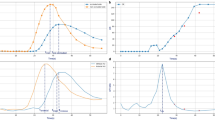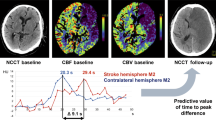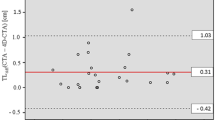Abstract
Objectives
In acute stroke patients with large vessel occlusion, collateral blood flow affects tissue fate and patient outcome. The visibility of collaterals on computed tomography angiography (CTA) strongly depends on the acquisition phase, but the optimal time point for collateral imaging is unknown.
Methods
We analysed collaterals in a time-resolved fashion using four-dimensional (4D) CTA in 82 endovascularly treated stroke patients, aiming to determine which acquisition phase best depicts collaterals and predicts outcome. Early, peak and late phases as well as temporally fused maximum intensity projections (tMIP) were graded using a semiquantitative regional leptomeningeal collateral score, compared with conventional single-phase CTA and correlated with functional outcome.
Results
The total extent of collateral flow was best visualised on tMIP. Collateral scores were significantly lower on early and peak phase as well as on single-phase CTA. Collateral grade was associated with favourable functional outcome and the strength of this relationship increased from earlier to later phases, with collaterals on tMIP showing the strongest correlation with outcome.
Conclusions
Temporally fused tMIP images provide the best depiction of collateral flow. Our findings suggest that the total extent of collateral flow, rather than the velocity of collateral filling, best predicts clinical outcome.
Key Points
• Collateral flow visibility on CTA strongly depends on the acquisition phase
• tMIP offers the best visualisation of the extent of collaterals
• Outcome prediction may be better with tMIP than with earlier phases
• Total extent of collaterals seems more important than their filling speed
• If triggered too early, CTA may underestimate collateral flow



Similar content being viewed by others
Abbreviations
- 4D CTA:
-
Four-dimensional computed tomographic angiography
- ASPECTS:
-
Alberta Stroke Program Early CT Score
- CBF:
-
Cerebral blood flow
- CBV:
-
Cerebral blood volume
- ICC:
-
Intraclass correlation coefficient
- MIP:
-
Maximum intensity projection
- MMCT:
-
Multi-modal Computed Tomography
- mRS:
-
Modified Rankin Scale score
- NIHSS:
-
National Institutes of Health stroke scale
- rLMC:
-
Regional leptomeningeal score
- spCTA:
-
Single-phase computed tomography angiography
- TICI:
-
Thrombolysis in cerebral infarction
- tMIP:
-
Temporal maximum intensity projection
- TTD:
-
Time to drain
- VPCT:
-
Volume perfusion computed tomography
References
Bang OY, Saver JL, Kim SJ et al (2011) Collateral flow predicts response to endovascular therapy for acute ischemic stroke. Stroke 42:693–699
Calleja AI, Cortijo E, Garcia-Bermejo P et al (2013) Collateral circulation on perfusion-computed tomography-source images predicts the response to stroke intravenous thrombolysis. Eur J Neurol 20:795–802
Lima FO, Furie KL, Silva GS et al (2010) The pattern of leptomeningeal collaterals on CT angiography is a strong predictor of long-term functional outcome in stroke patients with large vessel intracranial occlusion. Stroke 41:2316–2322
Maas MB, Lev MH, Ay H et al (2009) Collateral vessels on CT angiography predict outcome in acute ischemic stroke. Stroke 40:3001–3005
Menon BK, Smith EE, Modi J et al (2011) Regional leptomeningeal score on CT angiography predicts clinical and imaging outcomes in patients with acute anterior circulation occlusions. AJNR Am J Neuroradiol 32:1640–1645
Tan IY, Demchuk AM, Hopyan J et al (2009) CT angiography clot burden score and collateral score: correlation with clinical and radiologic outcomes in acute middle cerebral artery infarct. AJNR Am J Neuroradiol 30:525–531
Smit EJ, Vonken EJ, van der Schaaf IC et al (2012) Timing-invariant reconstruction for deriving high-quality CT angiographic data from cerebral CT perfusion data. Radiology 263:216–225
Pulli B, Schaefer PW, Hakimelahi R et al (2012) Acute ischemic stroke: infarct core estimation on CT angiography source images depends on CT angiography protocol. Radiology 262:593–604
Frölich AM, Psychogios MN, Klotz E, Schramm R, Knauth M, Schramm P (2012) Antegrade flow across incomplete vessel occlusions can be distinguished from retrograde collateral flow using 4-dimensional computed tomographic angiography. Stroke 43:2974–2979
Menon BK, O'Brien B, Bivard A et al (2013) Assessment of leptomeningeal collaterals using dynamic CT angiography in patients with acute ischemic stroke. J Cereb Blood Flow Metab 33:365–371
Kim SJ, Noh HJ, Yoon CW et al (2012) Multiphasic perfusion computed tomography as a predictor of collateral flow in acute ischemic stroke: comparison with digital subtraction angiography. Eur Neurol 67:252–255
Frölich AM, Schrader D, Klotz E et al (2013) 4D CT angiography more closely defines intracranial thrombus burden than single-phase CT angiography. AJNR Am J Neuroradiol. doi:10.3174/ajnr.A3533
Frölich AM, Psychogios MN, Klotz E, Schramm R, Knauth M, Schramm P (2012) Angiographic Reconstructions From Whole-Brain Perfusion CT for the Detection of Large Vessel Occlusion in Acute Stroke. Stroke 43:97–102
Abels B, Klotz E, Tomandl BF, Kloska SP, Lell MM (2010) Perfusion CT in acute ischemic stroke: a qualitative and quantitative comparison of deconvolution and maximum slope approach. AJNR Am J Neuroradiol 31:1690–1698
Lin K, Rapalino O, Lee B et al (2009) Correlation of volumetric mismatch and mismatch of Alberta Stroke Program Early CT Scores on CT perfusion maps. Neuroradiology 51:17–23
Parsons MW, Pepper EM, Chan V et al (2005) Perfusion computed tomography: prediction of final infarct extent and stroke outcome. Ann Neurol 58:672–679
Sillanpaa N, Saarinen JT, Rusanen H et al (2012) The clot burden score, the Boston Acute Stroke Imaging Scale, the cerebral blood volume ASPECTS, and two novel imaging parameters in the prediction of clinical outcome of ischemic stroke patients receiving intravenous thrombolytic therapy. Neuroradiology 54:663–672
Psychogios MN, Schramm P, Frolich AM et al (2013) Alberta Stroke Program Early CT Scale evaluation of multimodal computed tomography in predicting clinical outcomes of stroke patients treated with aspiration thrombectomy. Stroke 44:2188–2193
Yoo AJ, Hu R, Hakimelahi R et al (2012) CT angiography source images acquired with a fast-acquisition protocol overestimate infarct core on diffusion weighted images in acute ischemic stroke. J Neuroimaging 22:329–335
Kloska SP, Dittrich R, Fischer T et al (2007) Perfusion CT in acute stroke: prediction of vessel recanalization and clinical outcome in intravenous thrombolytic therapy. Eur Radiol 17:2491–2498
Lin K, Rapalino O, Law M, Babb JS, Siller KA, Pramanik BK (2008) Accuracy of the Alberta Stroke Program Early CT Score during the first 3 hours of middle cerebral artery stroke: comparison of noncontrast CT, CT angiography source images, and CT perfusion. AJNR Am J Neuroradiol 29:931–936
Miteff F, Levi CR, Bateman GA, Spratt N, McElduff P, Parsons MW (2009) The independent predictive utility of computed tomography angiographic collateral status in acute ischaemic stroke. Brain 132:2231–2238
Acknowledgments
The department has a research agreement with Siemens AG, Forchheim, Germany. Andreas Frölich, Michael Knauth and Peter Schramm have received speaker’s honoraria from Siemens AG, Forchheim, Germany. Ernst Klotz is a full-time employee of Siemens AG, Forchheim, Germany.
We would like to inform you that part of the current patient collective (about two-thirds of the population) has been subject to previous analyses. However, the current study reports fundamentally new data on collateral strength assessed in a time-resolved fashion, while previous analyses were focused on the delineation of thrombi [12], the depiction of incomplete vascular occlusions [13] and the predictive value of perfusion parameter maps [18].
Author information
Authors and Affiliations
Corresponding author
Rights and permissions
About this article
Cite this article
Frölich, A.M.J., Wolff, S.L., Psychogios, M.N. et al. Time-resolved assessment of collateral flow using 4D CT angiography in large-vessel occlusion stroke. Eur Radiol 24, 390–396 (2014). https://doi.org/10.1007/s00330-013-3024-6
Received:
Revised:
Accepted:
Published:
Issue Date:
DOI: https://doi.org/10.1007/s00330-013-3024-6




